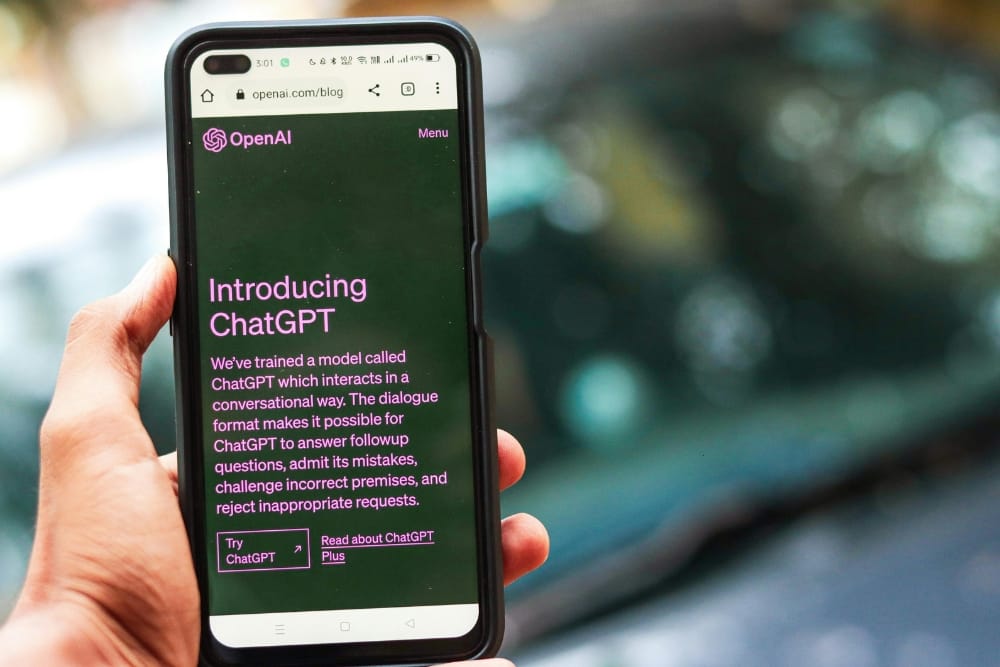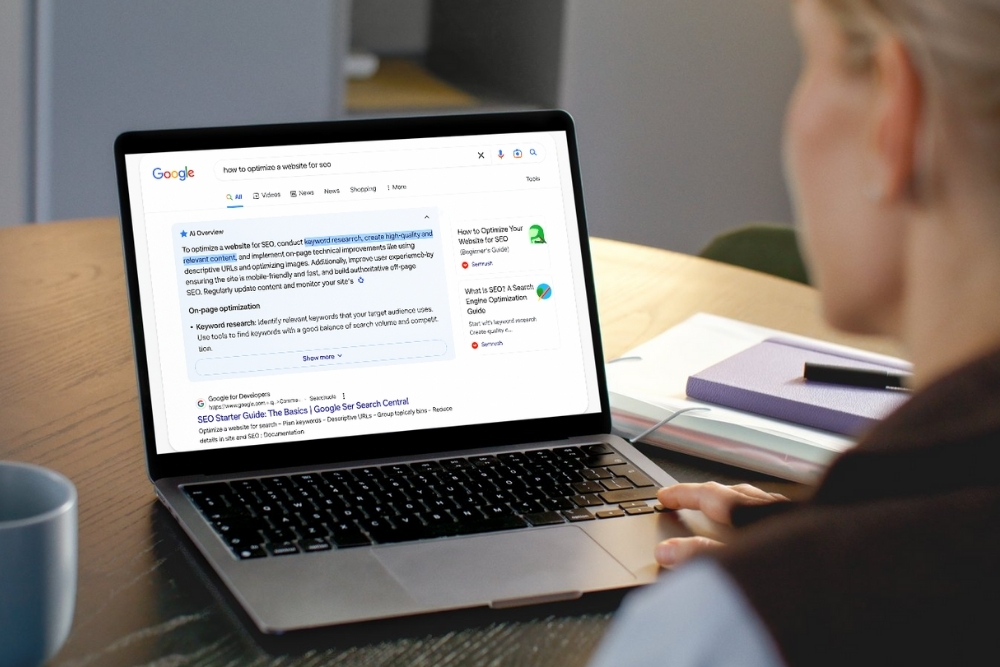13% of top-performing Google content is now AI-generated. Wild, right?
Not too long ago, the idea of using AI to create content sounded like a lazy shortcut. Now? It’s a full-blown SEO strategy – and for some, a confusing one. Is it genius… or could it hurt your SEO?
If you’ve ever wondered whether AI-generated content is a ranking rocket or a search engine penalty waiting to happen, you’re not alone. With everyone and their grandma using AI tools to churn out blogs, emails, and “thought leadership” posts, the line between smart content creation and low-quality content is getting blurrier than a screenshot of a screenshot.
In this article, we’re digging into the truth about AI-written content, its real impact on SEO, and how to use AI without tanking your organic traffic. You’ll get practical tips for content optimisation, using AI content generation responsibly, and crafting content that actually performs.
Because AI can do a lot, but you still need to know how to make your content count.
What Is AI-Generated Content?
Let’s clear something up: not all content created with AI is created by AI. AI-generated content refers to text, images, or other media created by artificial intelligence systems like ChatGPT, Jasper, or Copy.ai. These tools use generative AI to produce content at scale, often from simple prompts. Handy? Yes. Foolproof? Not quite.
AI Content vs. AI-Written Content vs. Human-Edited Content
Here’s where it gets interesting and relevant to your SEO strategy.
- AI content is a broad term. It includes everything from AI-assisted outlines to full-blown blog posts churned out by language models.
- AI-written content is typically text entirely generated by an AI tool with little or no human involvement. This is the kind that might hurt your SEO if it lacks context, originality, or quality.
- Human-edited content is the secret sauce. It’s AI-generated content that’s reviewed, refined, and optimised by actual people. Think of it as turning your AI intern’s draft into publishable material.
Editing makes a big difference. Google’s helpful content system favours content that demonstrates real value, depth, and expertise – qualities that often require a human touch.
Types of AI Tools for Content Generation
Let’s talk tools. Whether you’re trying to scale blog production or simply beat writer’s block, there’s an AI tool for that:
- ChatGPT: Great for ideation, outlines, and conversational-style content. It’s flexible but needs editing to meet SEO standards.
- Jasper: Known for its marketing-focused templates and faster workflow for social, ads, and long-form posts.
- Copy.ai, Writesonic, SurferSEO: These combine content generation with keyword suggestions and basic SEO tools.
Using these tools strategically can boost your content creation process, but it’s important to remember: AI can’t replace a solid SEO strategy, it can only support it.
So yes, using AI-generated content can save time and improve output, but relying on AI alone won’t get you to page one on Google. SEO success still depends on contextually relevant content, proper keyword research, and understanding how your audience thinks.
Can AI-Generated Content Hurt Your SEO Rankings?
Short answer? Yes. But it’s not the AI’s fault, it’s how you use it that matters.
How Search Engines Interpret AI-Generated Content
Search engines like Google aren’t on a witch hunt for AI content. They care about one thing: value to the user.
Whether your blog was written by a caffeinated intern or an AI tool doesn’t matter as long as the content is helpful, accurate, and trustworthy. But if your AI-generated content is thin, vague, or repetitive? That’s where the problems start. Google’s algorithms don’t judge how content is made – they judge how it performs in terms of usefulness and relevance.
And in a world of AI-powered search and rapid content generation, Google is doubling down on rewarding what it calls “people-first content.”
The Risks of Low-Quality, Spammy, or Duplicate Content
Here’s where AI-generated content can hurt your SEO:
- Low-quality content: If you’re using AI tools to pump out keyword-stuffed articles without adding value, your content will likely get buried.
- Spammy structure: Content that reads like it was generated in 0.3 seconds often was – and users can tell. If they bounce, so do your rankings.
- Duplicate content: Using AI to generate multiple variations of the same blog post might seem clever… until Google starts ignoring all of them.
Search engines want original, high-quality content that speaks directly to the user’s intent. AI-written content that lacks nuance, structure, or credibility can backfire fast.
Google’s Helpful Content System & E-E-A-T
Ah yes, the acronym buffet.
Google’s Helpful Content System is designed to demote content that seems created primarily to chase SEO rankings, especially when it’s generic or doesn’t reflect real-world experience. This is where E-E-A-T comes in: Experience, Expertise, Authoritativeness, and Trustworthiness.
AI can assist in content creation, but it can’t replace personal insight, industry expertise, or a unique point of view. And if your site is flooded with AI-driven content that lacks these qualities? You might see your search rankings drop like your Wi-Fi during a Zoom pitch.
So, can AI content generation support your SEO strategy? Absolutely. But only if you treat AI as a tool, not a substitute. Great content still requires human oversight, contextual depth, and a focus on the reader, not just the algorithm.
Google’s Stance: Does It Penalise AI-Written Content?
Let’s bust a myth: Google doesn’t automatically penalise AI-written content.
What it does penalise is bad content – and bad content just happens to be something a lot of folks crank out using AI tools without thinking twice.
What Google Actually Looks For
Google’s algorithms don’t scan for phrases like “written by ChatGPT.” Instead, they’re trained to evaluate whether content is useful, original, and aligned with user intent. It doesn’t matter if the content came from an AI tool or a copywriter, if it’s thin, repetitive, or clearly churned out without care, you’re asking for a dip in rankings.
This is where using AI-generated content becomes tricky. If you don’t edit the output, skip proper keyword research, or just drop a bunch of SEO buzzwords into a robotic blog post, your site could start falling in search results. Not because it’s AI, but because it’s bad.
Common Mistakes That Hurt Your SEO
Let’s look at a few rookie mistakes that can sabotage your SEO strategy:
- Unedited output: AI content often sounds polished on the surface, but closer inspection reveals vague phrasing and generic advice. If you hit publish without editing, Google (and your readers) will notice.
- Keyword stuffing: It’s tempting to tell your AI tool to use “SEO strategy” 47 times. Don’t. This old-school trick not only makes your content unreadable but also signals to Google that you’re gaming the system.
- Lack of originality: Many AI tools generate content that feels like it was scraped from Wikipedia’s greatest hits. Without a unique voice, perspective, or insight, your content blends into the noise.
Need help with AI content creation that won’t hurt your SEO?
Whether you’re optimising for ranking, improving your content strategy, or figuring out how to use AI tools effectively, SEOBoost helps you create AI-generated content for SEO that actually delivers SEO benefits.
Real Examples of Penalties and Ranking Drops
Still think AI-generated content can’t hurt your SEO? Let’s look at what happens when using AI-generated content skips quality for convenience and the SEO performance nosedives.
Case 1: Google’s March 2024 Core Update
In March 2024, Google launched a core update that directly targeted low-quality content generation, particularly AI content creation that fails to demonstrate value. According to Search Engine Journal, the update penalised sites using AI tools to generate articles that didn’t align with its Helpful Content System or E-E-A-T standards. This signalled a clear shift in how SEO and content are evaluated: content must be helpful, not just technically accurate.
Case 2: “Civille” – A Traffic Freefall
A niche site known as “Civille” leaned heavily on AI-written content for six months. It published dozens of blogs using AI tools like ChatGPT, but skipped essential human editing. The result? A dramatic drop from 1,600 organic visitors to just 350. Search rankings collapsed, proving that AI-generated content without thoughtful optimisation can absolutely hurt your SEO.
Case 3: Nao Medical’s Content Chaos
In 2023, Nao Medical made headlines for uploading a surreal collection of AI-generated content that included unicorns on ketamine and random medical oddities. Their content creation process was clearly automated and unchecked. Google flagged it for scaled content abuse, demonstrating how content that lacks originality or context gets penalised, regardless of intent.
Case 4: Clickbait Content Farms Burn Out
A Wired report uncovered a network of over 2,000 domains flooded with AI-driven content, some even featuring fake bylines to appear more trustworthy. These clickbait farms initially saw traffic spikes, but as Google’s AI search systems improved, the sites were de-indexed. This illustrates that publishing content without editorial oversight not only devalues your site, it could get your website penalised by Google.
How to Use AI As A Tool for Content Creation
The secret to making AI-generated content work for your SEO strategy isn’t more automation – it’s smarter execution.
AI tools like ChatGPT, Jasper, and Copy.ai are powerful when used as creative partners, not copy-paste machines. The key is to use AI as a tool to streamline your content creation process – not as a shortcut to fill your blog with fluff.
Tips for Using AI-Generated Content Without Hurting Your SEO
Here’s how to leverage AI without letting it hurt your SEO:
- Start with human strategy: Before generating anything, define your audience, intent, and SEO goals. Use AI tools to generate outlines or initial drafts, not final products.
- Edit ruthlessly: AI content generation is fast but raw output is rarely publish-ready. Inject your voice, examples, and insight to ensure the content feels human.
- Check for originality: Duplicate or generic content can trigger search penalties. Always scan and refine AI-written content to ensure it’s contextually relevant and adds unique value.
- Use keyword data: Pair AI content creation with real keyword research. Tools like SurferSEO or Semrush help align your content with actual search demand.
- Optimise smartly: Don’t keyword stuff. Instead, naturally weave terms like “SEO and content” or “AI-generated content for SEO” into engaging, valuable content.
Using AI tools strategically means you’re combining the power of AI with human oversight to produce content that ranks and resonates.
SEO Best Practices for Using AI-Generated Content
If you’re going to use AI-generated content for SEO, follow these rules or risk being just another blog lost in the AI search abyss.
1. Focus on Quality Over Quantity
Just because you can quickly generate 20 articles doesn’t mean you should. Google prioritises high-quality content that’s helpful and well-structured. Thin content whether from a human or AI doesn’t perform.
2. Ensure Content Aligns with E-E-A-T
Your AI content must reflect Experience, Expertise, Authoritativeness, and Trustworthiness. That means adding personal insights, citing data, and showing you know what you’re talking about. AI doesn’t know your niche, you do.
3. Avoid Low-Quality and Spammy Tactics
- Don’t use AI to mass-produce repetitive articles across similar keywords.
- Don’t try to trick Google with keyword stuffing or fake bylines.
- Don’t skip human editing. Ever.
These mistakes not only make your SEO content worse, they can penalise your site, as we’ve seen in real cases where AI-generated content hurt traffic.
4. Use AI to Help, Not Replace
AI and SEO are a dynamic duo if used right. Use AI to:
- Generate outlines
- Summarise research
- Brainstorm title variations
- Structure pillar content
But always add a human layer to refine, validate, and publish.
5. Monitor Performance and Adjust
Track what works. Look at search results, bounce rates, and time-on-page. If your AI-written content isn’t driving traffic or engagement, revise it. AI helps you produce, but you still need to optimise for results.
AI Can Help – But Only If You Help It First
AI content isn’t the enemy. In fact, when used right, it can be one of your best allies in crafting an SEO strategy that boosts your ranking and drives real results.
But here’s the catch: AI-generated content can still hurt your SEO if it’s published without purpose, polish, or a plan. Not every AI tool understands your audience, your industry, or your voice. That’s still your job.
So before you hit publish on that next AI-written article, ask yourself: Is this actually helping someone? Or am I just trying to fill space?
And if you’re not sure how to balance content marketing with smart AI content generation, or if your SEO and content plan needs a serious upgrade – we’ve got you. Whether it’s content optimisation, strategy, or just a second opinion, get in touch. We’re here to help you use AI as a tool to grow, not just generate.
Your content deserves better than “good enough.” Let’s make sure it gets there.




